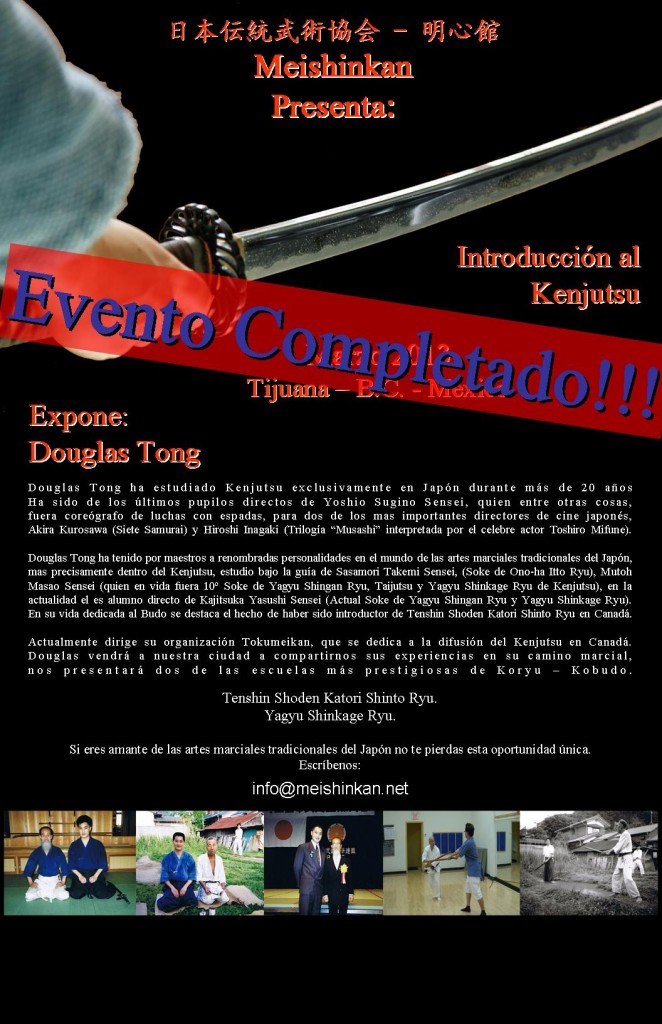
Seminar Report:
“Introduction to Kenjutsu” Seminar
March 2013
Tijuana, Baja California, Mexico
My Impressions of an Exceptional Weekend
copyright © 2013 Esteban Voto, all rights reserved.
__________________________________________________
Prior to the event, I had worked on making arrangements and preparing for the seminar for about nine or ten months. It was really amazing when Douglas Tong Sensei finally arrived in our city of Tijuana. I could not believe it. I could not believe that he was actually here. After so much effort to bring him over, it was incredible that we were finally going to meet him.

Receiving gifts (with Sensei Esteban Voto)
It seemed almost magical, and perhaps many of the participants had no idea of the true significance of this event; namely, that we were bringing two of the most important martial traditions of Japan to our fair city of Tijuana, Mexico, by way of this teacher, Douglas Tong Sensei.
Maybe due to a lack of experience, the participants expected this kenjutsu seminar to be something easy. For example, perhaps they thought that they could just come to the dojo, see the Master, enjoy the sessions, share with Sensei some good times, and when it was over, they would just return home, and that would be the end of the story. But, on the contrary, it wasn’t so simple. This “seminar” was totally different than what they had expected. This intensive experience required an investment of “Time” and it also required that the participants go through a great “Process” of change. I hope that the reader does not judge this comment as some kind of complaint on my part because it clearly is not. Because I love martial arts so much, I really want to highlight the importance of this investment of time and the necessity of the process that we must go through in learning.
If the reader will permit me, I would like to compare this situation to a very interesting experience that I had with a friend once. I went with this dear friend to dinner at a restaurant serving mainly grilled meat. The restaurant was very good. It had a good atmosphere. There was good drink, and of course the company of a close friend always helps us enjoy the moment more. While we were eating these “meats”, which had been slow-cooked on the grill, my friend made a comment. “This meat is delicious,” he said.
I said “Yes, that’s right. It is very well cooked. It was cooked with a good fire, not too strong, but cooked slowly. Did you notice that it took some TIME … a good bit of time?”
My friend then made an observation, “If that is so, then why do you like sashimi so much?” He asked me this knowing that I like thin cuts of raw fish, and then added, “Sashimi is made precisely at the time that you order it and it is done without any cooking. It is the complete opposite of this!”
I said, “Yes but you’re a little mistaken. Both do take time. In order for the fish to get to your plate, it also has to go through a process and it takes some “time” to prepare. It does not immediately come to your table. The process might look a little different but basically they are the same. All good things take time, and they all must go through a certain process before they are ready.”
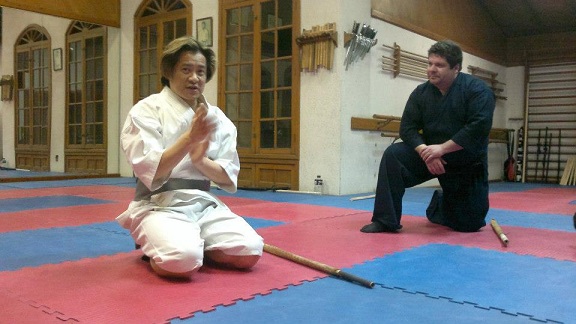
Tong Sensei talking to the students
Well coming to the point, the first impression I had about Douglas Tong Sensei was that he was a “cheerful” man, with an excellent sense of humour, always kind, always willing and ready, and I was not wrong in my estimation. Sensei shared with us so much knowledge that many were left dizzy from the amount of detail he provided. It was so intoxicating that it felt like we were drunk, even though we did not even have a drop of alcohol. Armed with our willingness to learn things as best we could, it seemed like we were thirsty sponges ready to absorb anything that Sensei wanted to teach us. It was really amazing. Tong Sensei gave everything of himself completely. He came to do what he knows best and he sure did a great job. I really don’t have the words to thank him for coming to visit us.
As the days passed, he let us see who he truly is: a simple and very humble man. He never asked us for anything extravagant or special. He never portrayed himself as some “GREAT MASTER” or anything like that. He was always willing to accept what we were humbly able to give him. And at all times, he made us feel very good about everything we did. He gave his attention to every one of the participants and helped us all learn more and improve our skills and abilities in kenjutsu (Japanese swordfighting).
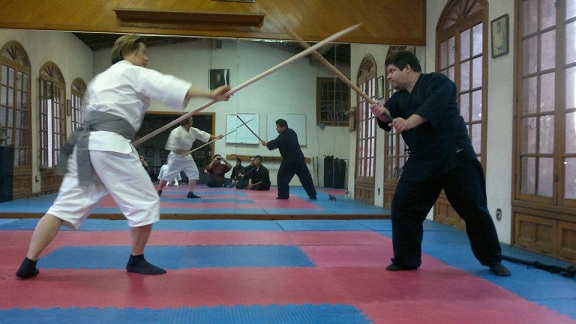
bojutsu
On the first day, we started on time. The schedule said that the evening session would be from 6:00 to 7:30 pm. Well, this was not so. We trained until 11:00 pm! This was incredible for someone who had just flown for 9 hours from Canada to San Diego, and then crossed the border into Mexico, which takes a long time. I do not know many teachers who would be willing to do this.
The next two days were more of the same. There was lots of activity, and a lot to experience and learn about from a style as unique as Tenshin Shoden Katori Shinto Ryu. What did it feel like inside the Dojo? Time seemed to stop while we continued training and training, more and more, and yet Tong Sensei always seemed fresh like fresh lettuce.
In the early hours of the fourth day, we had the good fortune to be able to take Sensei to a local TV station since they wanted to interview us. The space in the studio was very small and the time very short. We had about ten minutes of “air-time” to demonstrate and talk about Kenjutsu. Douglas Sensei performed a flawless demonstration of Katori Shinto Ryu iaijutsu. Everyone in the TV studio was speechless. It was a wonderful experience.
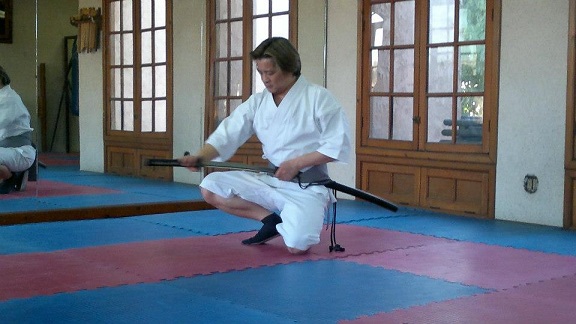
iaijutsu
After this, we had breakfast and again headed toward the Dojo. That day, we had a special class. Only a very select group was invited. At this time, Douglas Sensei introduced us to the wonderful world of Yagyu Shinkage Ryu. He also shared with us some of his interesting stories about his Sensei, Soke Kajitsuka, and his experiences in Shinkage Ryu. It made us dream that someday we might also be able to meet this great Master of his.
After lunch, we had more practice. We had originally planned to practice only a few hours in the afternoon, maybe an hour and a half or two at the most. We had planned to take Sensei for a walk on the beaches of Tijuana, have some coffee at the beach, take some pictures, talk some more, and then take him back to his hotel so that Sensei could get a good rest. However, he preferred to remain in the Dojo and to continue teaching us. His dedication to Budo is really admirable. He is truly passionate about the art of the sword.
When it got late, two of the people who were with us had to go home. It was already night, and they had to return to see their families and to attend to their affairs. Together with my student and friend Hector, we kept training. Sensei then took this opportunity to let me know something about Itto Ryu. I very much like the frontal aspect of this simple and imposing style. My admiration for this style was perhaps influenced by the 6 or 7 years I spent practicing Kendo, the art of Japanese fencing, which was primarily inspired by this old style of kenjutsu. The experience was fun, educational, and spiritually nourishing.
Later in the night, we had the pleasure of sharing one last supper with Sensei. It was splendid. I was fortunate enough to get some advice from him about some of my personal circumstances and situations, and his answers really helped me tremendously to “clear my mind”. Isn’t it curious that my organization is called Meishinkan (Hall of the Clear Mind)? Is it merely a coincidence? Or is it perhaps chance or destiny? I do not know. You can interpret it however you like.
After this excellent dinner, we went to his hotel so that Sensei could finally get some rest, because the next morning, he had to be at the airport early. So when we arrived at the hotel, I helped Sensei to carry his belongings to his room. Once we got there, he invited me to stay a while. He then said to me, “There’s one last thought that I want to share with you.”
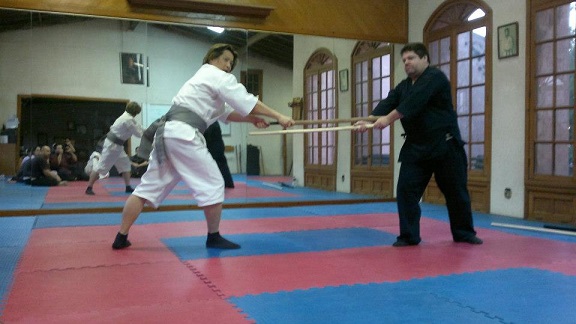
kenjutsu
He pulled out two fukuro shinai and he asked me to attack him repeatedly, and for the next 8 to 10 minutes, he shared with me some further concepts from Katori Shinto Ryu and Yagyu Shinkage Ryu. This helped me to continue “clearing my mind” about a great many things.
Well, what more can I say that has not already been said? What more can I add? I could spend hours and hours talking about this experience, but I think that I would never be able to express everything that I would like to. This is the fifth time that I have organized an international seminar in Budo (although it was the first time for me to deal in the art of the sword). During the more than 36 years that I have spent studying budo, rarely have I met a person as noble as this Master.
It just remains for me to say the following: Thank you Douglas Tong Sensei. Thank you for coming so far. Thank you for all that you gave us. Thank you for agreeing to be my Master, because as it is well known in the true path of Budo, it is not the student who chooses the teacher. It is the teacher who chooses the student.
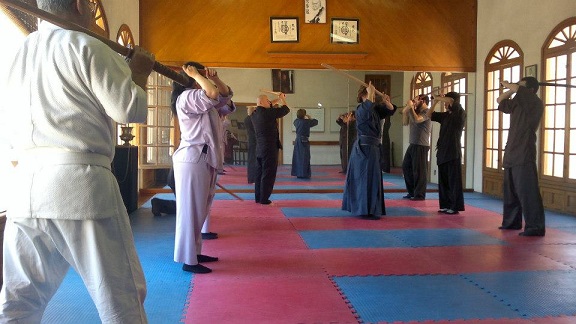
Sensei teaching kihon
I hope with all my heart that all who participated in this seminar enjoyed these days of learning. I hope that they really understand and value what has happened in our city, that it does not pass unnoticed and eventually be forgotten, and that it will serve to sow seeds for the future, which will grow good roots and give good fruit, and hopefully from this good beginning, we can continue down this road.
Thank you to everyone who supported us. Thank you to those who were there from the beginning of this project. Thank you to those who believed in this venture. In the end, everything worked out well. We had the “right” people, the people with the “right” attitude and energy. Without all these wonderful people, pulling off a project of this magnitude would not have been possible. My thanks to you all.
Esteban Voto
Meishinkan
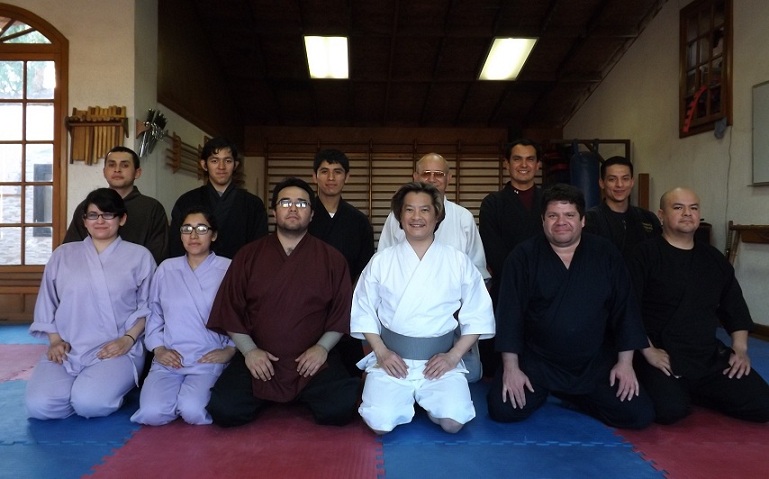
Meishinkan Group (Tijuana, Mexico 2013)
__________________________________________________
Tong Sensei was interviewed on Hola Californias, a morning television show much like Good Morning America, CBS This Morning, and the like, which is watched throughout the state of Baja California and in the San Diego Metropolitan Area as well. Here is the interview:
__________________________________________________
